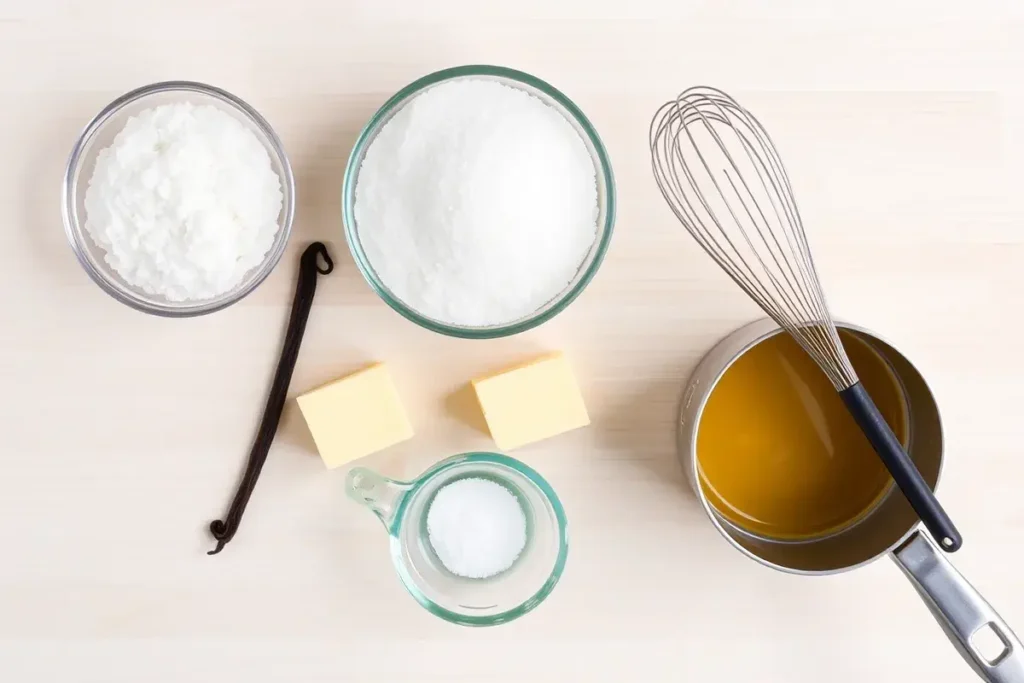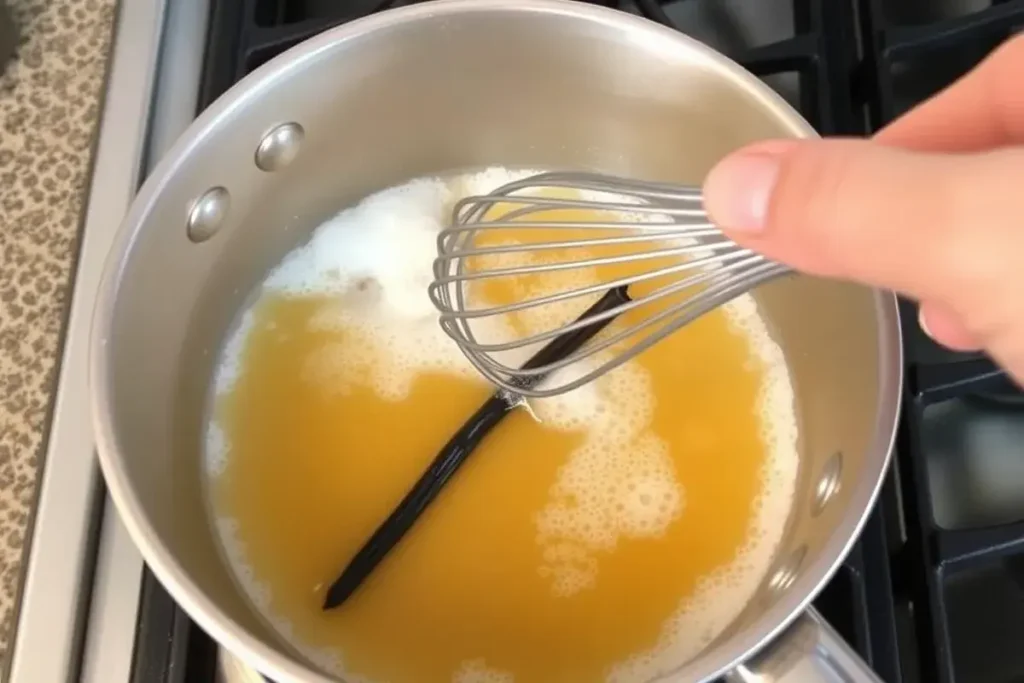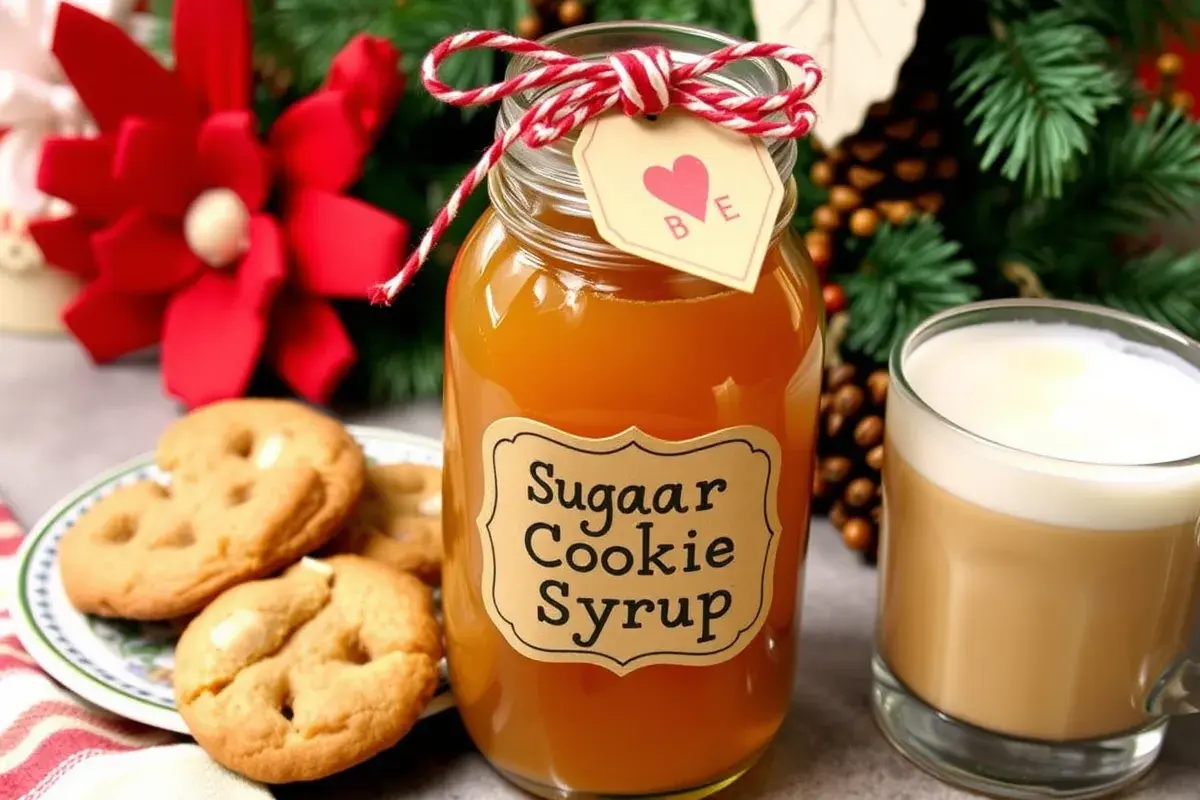Creating the perfect sugar cookie syrup can seem daunting. However, once you understand its versatility and depth of flavor, you will realize how beneficial it is to have this sweet delight on hand. In fact, sugar cookie syrup elevates coffee, cocktails, baked goods, and even breakfast items. Because of its nostalgic taste, many people associate the syrup’s comforting flavor with homemade cookies straight from the oven.
This comprehensive guide will explore everything about sugar cookie syrup. You will learn where it came from, why it is so popular, which ingredients work best, and how to make it at home. We will also cover countless ways to use this syrup, along with storage tips, common mistakes to avoid, and even healthier substitutions. Consequently, by the time you finish reading, you will be well-equipped to whip up the ultimate sugar cookie syrup for any occasion.
1. The Origins of Sugar Cookie Syrup
Many modern food products have interesting backstories. Sugar cookie syrup is no exception. Tracing its roots involves looking at popular cookie traditions, nostalgic flavor preferences, and a drive to innovate in the culinary world. Therefore, understanding the syrup’s evolution helps you appreciate its sweet simplicity.
1.1 Tracing Cookie Flavor Popularity
Sugar cookies have been enjoyed for centuries. They typically feature a buttery base, sweetener, and subtle vanilla or almond undertones. Although sugar cookies were first popularized in Europe, they became a staple in the American baking scene. Over time, bakers refined their recipes to produce that familiar soft and sweet dough. Consequently, the sugar cookie was soon a symbol of home-baked comfort.
The transition from cookie to syrup occurred when coffee shops and specialty beverage makers discovered how to bottle that beloved cookie taste. Extracting flavors, like vanilla, butter, and warm sugar, sparked the creation of concentrated syrups. Thus, sugar cookie syrup was born out of an effort to replicate that fresh-baked aroma in a liquid form, which can be used in drinks, frostings, or drizzles.
1.2 Why Converting a Cookie into a Syrup?
- Flavor Accessibility: Many people want an instant flavor boost. Sugar cookie syrup offers that without requiring a full batch of cookies.
- Versatility: A syrup can be added to multiple recipes, ranging from breakfast waffles to cocktails.
- Extended Shelf Life: Cookies can go stale quickly. In contrast, syrup, when stored correctly, remains fresh longer.
Additionally, restaurants and cafés embrace sugar cookie syrup because it enables rapid preparation of themed lattes and signature desserts. For example, holiday-themed drinks often rely on this flavor to evoke festive memories. Therefore, sugar cookie syrup perfectly taps into the consumer’s craving for sweet nostalgia.
1.3 The Growth in the Gourmet Market
The gourmet flavor market has seen a dramatic rise in artisanal syrups. Sugar cookie syrup is part of a larger trend of replicating dessert flavors in liquid form. Specialty shops now feature everything from tiramisu and crème brûlée syrups to unique, limited-edition holiday blends. This innovative scene fuels the spread of sugar cookie syrup, placing it in the spotlight alongside other dessert-inspired syrups.
Moreover, social media has propelled the popularity of these syrups. Food bloggers and Instagram influencers often share recipes or pictures highlighting sugar cookie syrup in creative beverages or pastries. Consequently, the consumer demand for this sweet elixir continues to soar.
2. Why Sugar Cookie Syrup Is So Popular
It is no secret that sugar cookie syrup has gained a devoted following. However, its popularity is more than just a sugary fad. The flavor, convenience, and nostalgic element make it a must-have for home kitchens and professional cafés alike.
2.1 Nostalgic Flavor Profile
The hallmark of a classic sugar cookie is its balance of buttery sweetness and vanilla warmth. Sugar cookie syrup captures these qualities in a concentrated form. Therefore, anyone craving that delightful memory of fresh-baked goods can indulge without baking an entire batch of cookies. This strong association with home-baked comfort often prompts people to reach for it, especially during the holidays or on rainy afternoons.
2.2 Versatility in Different Culinary Applications
- Beverages: From coffee and tea to cocktails, this syrup transforms ordinary drinks into indulgent treats.
- Baking: You can fold a splash of sugar cookie syrup into cake batters or pancake mixes for extra sweetness.
- Drizzles and Toppings: Pour it over ice cream, waffles, or fruit. It delivers instant flavor.
For example, adding a shot of sugar cookie syrup to your latte instantly upgrades your morning routine. Meanwhile, a drizzle on homemade scones offers a sweet finishing touch. Because of these convenient applications, the syrup remains in high demand among both casual cooks and culinary professionals.
2.3 Ease of Use
The liquid format means you can measure and add sugar cookie syrup without any fuss. Traditional sugar cookie dough requires mixing, rolling, and cutting. Conversely, a syrup demands less labor and time. Therefore, busy individuals can enjoy a cookie-inspired treat with minimal effort.
Additionally, the syrup’s consistency enables it to blend seamlessly with other liquids. For instance, stirring a spoonful into cream or milk results in a quick dessert sauce. Because you skip the typical baking steps, sugar cookie syrup appeals to those who want instant gratification.
2.4 Expanding Flavor Combos
this recipe pairs well with other flavors. Combining it with spices such as cinnamon or cardamom can produce a chai-like sweetness. Alternatively, blending it with citrus zest results in a refreshing spin on a classic. Thus, bartenders and pastry chefs use sugar cookie syrup to innovate. They create new recipes that intrigue consumers, driving further popularity for this syrup.
3. Key Ingredients for Homemade Sugar Cookie Syrup
Crafting an exceptional sugar cookie syrup begins with quality ingredients. Although recipes can vary, certain elements remain consistent. Each ingredient serves a particular function, ensuring that the final syrup delivers the sweet, buttery, and vanilla-rich punch consumers expect.
3.1 Granulated Sugar
Sugar forms the backbone of this syrup. Granulated sugar dissolves evenly, creating a smooth texture. Some recipes incorporate brown sugar for a deeper caramel note. However, granulated sugar remains essential for capturing that bright, sweet cookie flavor.
3.2 Vanilla Extract or Vanilla Beans
Vanilla defines the iconic taste of sugar cookies. High-quality extracts provide a potent flavor that resonates in the finished syrup. You can also use vanilla bean pods for a more luxurious touch. Splitting the pods and simmering them in your syrup imparts a rich aroma. Therefore, the choice between extract or vanilla beans depends on your preferences and budget.
3.3 Butter or Butter Flavoring
The buttery note is crucial. Traditional sugar cookies lean heavily on butter for their melt-in-your-mouth texture. To replicate that richness, many syrups include a small amount of real butter or a concentrated butter flavoring. However, some prefer to keep the syrup dairy-free, opting for butter extract instead. Both methods can achieve that signature smoothness.
3.4 Salt
A pinch of salt can enhance the sweetness and depth of the syrup. Salt balances sugar, ensuring that the final product does not taste flat. Because sugar cookies often rely on salt to enrich their flavor, it makes sense that a sugar cookie syrup would include a similar component.
3.5 Water and Thickeners
Combining sugar and water creates the syrup base. However, you also need to consider thickness. Many people simmer the mixture until it reduces slightly. Others add cornstarch or a stabilizer for consistent viscosity. Be careful: over-thickening may produce a sauce rather than a pourable syrup. Therefore, monitor your cooking process closely to achieve the right texture.
4. Step-by-Step Guide to Making Sugar Cookie Syrup at Home

Although you can purchase this recipe in stores, making your own can be rewarding. You control the quality of ingredients and can adjust the recipe to your taste. The process is straightforward and requires minimal kitchen expertise.
4.1 Gather Your Equipment
- Medium Saucepan: For simmering the ingredients.
- Whisk or Spoon: To stir the syrup while it reduces.
- Measuring Cups and Spoons: Precision ensures consistency.
- Strainer (Optional): Helps remove any vanilla bean residues.
4.2 Basic Sugar Cookie Syrup Recipe
Ingredients:
- 1 cup granulated sugar
- 1 cup water
- 2 tablespoons unsalted butter (or 1 teaspoon butter extract)
- 1 tablespoon pure vanilla extract
- ¼ teaspoon salt

Instructions:
- Combine Sugar and Water: Add sugar and water to your saucepan. Stir gently over medium heat.
- Bring to a Simmer: Once you see gentle bubbles, reduce the heat slightly. Continue stirring so the sugar fully dissolves.
- Add Butter and Salt: Stir in the unsalted butter and salt. If using butter extract, wait until later to maintain its potency.
- Let It Thicken: Simmer for about five to ten minutes. The syrup will reduce slightly. Do not let it boil rapidly.
- Incorporate Vanilla: Remove the saucepan from heat. Then, stir in the vanilla extract (or butter extract if using that instead).
- Cool and Store: Allow the syrup to cool before transferring it to a sealed container.
Pro Tip: If you want a stronger cookie taste, consider adding a splash of almond extract. Alternatively, you can whisk in a pinch of cinnamon or nutmeg for a holiday twist.
4.3 Adjusting Consistency
You can modify the syrup’s thickness. For a thinner, more drizzle-friendly liquid, simmer for less time. For a sauce-like consistency, simmer a bit longer. However, keep a close eye to avoid overcooking. A thick syrup might crystallize or taste burnt if left on heat for too long.
4.4 Flavor Variations
- Brown Sugar Swap: Replace half the granulated sugar with brown sugar for caramel depth.
- Extra Butter Notes: Add an extra tablespoon of butter for more richness.
- Citrus Zest: Lemon or orange zest can bring brightness to the sweet base.
Therefore, customizing your sugar cookie syrup allows you to craft a flavor profile that matches your preference. Feel free to experiment until you find the perfect balance.
5. Innovative Uses for Sugar Cookie Syrup
Sugar cookie syrup offers versatility that goes far beyond sweetening a latte. Because of its subtle yet distinctive flavor, it can enhance a wide range of dishes. Below are innovative ways to make the most of this sweet treat.
5.1 Elevating Beverages
- Coffee Drinks: Add a shot of sugar cookie syrup to black coffee or espresso-based drinks. The buttery notes complement the roast.
- Tea Lattes: Stir a tablespoon into a chai or matcha latte for a comforting twist.
- Milkshakes and Smoothies: Blend a spoonful into vanilla shakes or fruity smoothies. Its warmth amplifies other flavors.
- Cocktails: Light rum, vodka, or cream liqueurs pair well with the syrup’s sweet cookie essence.
For instance, a Sugar Cookie Martini might mix vodka, cream, and a generous drizzle of sugar cookie syrup. A simple garnish of crushed sugar cookies around the rim adds visual appeal and further texture.
5.2 Baking Enhancements
- Frostings: Incorporate a bit of syrup into buttercream or whipped cream. The result is a sweet, subtly cookie-flavored topping.
- Cake Batters: Swap some liquid in your recipe for sugar cookie syrup to infuse the entire cake with that nostalgic flavor.
- Glazes: Drizzle over muffins or donuts to add extra sweetness and a glossy finish.
Because sugar cookie syrup already has butter and vanilla notes, it blends well with most dessert recipes. For example, you can create a swirl in pound cake batter. The swirl sets into a sweet ribbon that intensifies each slice.
5.3 Breakfast and Brunch Ideas
Breakfast items are prime real estate for a drizzle of sugar cookie syrup. Try these creative morning meal suggestions:
- Pancakes and Waffles: Replace traditional syrup with sugar cookie syrup. Top with fruit or whipped cream for extra decadence.
- Oatmeal Boost: Stir a teaspoon into warm oatmeal for a cookie-flavored treat.
- French Toast: Use sugar cookie syrup instead of powdered sugar or maple syrup. The butter notes blend seamlessly with custard-soaked bread.
- Yogurt Topping: Drizzle over Greek yogurt and sprinkle some granola for texture.
Therefore, starting your day with a sweet note becomes easier. You only need one or two tablespoons to impart a comforting flavor reminiscent of fresh-baked cookies.
5.4 Salty and Sweet Combinations
Beyond sweet treats, this recipe can enhance savory dishes if used wisely. For example, drizzle it lightly over candied bacon or incorporate it into a glaze for roasted vegetables. The contrast of sweet syrup with salt or spice can produce complex flavors that intrigue the palate.
6. Pairing Sugar Cookie Syrup with Other Flavors
While sugar cookie syrup is delicious on its own, pairing it with complementary tastes can create unexpected culinary highlights. Because of its mild profile, many flavor categories mesh well with it.
6.1 Fruit Pairings
- Berries: Strawberries, raspberries, or blueberries add a tart contrast.
- Stone Fruits: Peaches, apricots, or cherries bring natural sweetness.
- Citrus: Lemon or orange zest can brighten the syrup’s inherent warmth.
Because sugar cookies often feature fruit glazes or are served alongside fruit salads, these pairings feel natural. Drizzling a bit of syrup over fresh fruit amplifies sweetness.
6.2 Spice Infusions
Sometimes, a simple pinch of spice can upgrade your recipe experience. Consider stirring in cinnamon, nutmeg, or cardamom. This combination captures the essence of holiday baking. For instance, a hot cocoa spiked with sugar cookie syrup and a sprinkle of cinnamon can evoke cozy winter memories.
6.3 Complementing Chocolates
Many cookie flavors pair wonderfully with chocolate. Sugar cookie syrup is no different. Drizzle some syrup over brownies or molten chocolate cake for a sweet layer. Alternatively, swirl a dash into hot chocolate. The cookie essence balances the richness of cocoa.
6.4 Cheese and Dairy Products
Cheese boards often include sweet condiments, like jam or honey. A small dish of sugar cookie syrup offers a new twist. Soft cheeses like brie or mascarpone pair well with the syrup’s buttery undertones. Meanwhile, sharper cheeses, such as aged cheddar, benefit from a subtle sweet accent. Therefore, you can experiment with sweet-savory pairings during your next gathering.
7. Storing and Handling Sugar Cookie Syrup
Proper storage ensures your sugar cookie syrup remains fresh and flavorful. However, even the best ingredients can degrade if you do not follow a few basic guidelines. By observing best practices, you will extend your syrup’s shelf life and preserve its taste.
7.1 Ideal Storage Conditions
- Cool, Dark Place: Direct sunlight and heat can cause flavor changes.
- Airtight Containers: Glass jars or quality plastic bottles work well. Always check seals before storing.
- Refrigeration (Optional): Depending on your recipe, refrigeration can extend shelf life. However, if your syrup is fairly thick, cold temperatures may alter texture. Let it warm to room temperature before use.
7.2 Shelf Life Expectations
Homemade sugar cookie syrup typically lasts around two to four weeks when stored properly. Store-bought versions may contain preservatives, so they last longer. Always check labels. If your syrup develops an off odor or color, discard it. The presence of real butter or dairy extracts might shorten shelf life compared to a purely sugar-based syrup.
7.3 Preventing Crystallization
Crystallization occurs when dissolved sugar molecules begin to form solids again. To reduce this risk:
- Avoid Stirring Excessively: Once the syrup has cooled, too much stirring can encourage crystallization.
- Use Corn Syrup or Glucose Syrup: A small amount can help inhibit crystal formation.
- Store at Stable Temperatures: Fluctuations in heat can cause sugar molecules to reorganize.
Following these steps ensures your sugar cookie syrup maintains a smooth consistency. Therefore, it is ready to enhance your treats whenever you crave a sweet hint of nostalgia.
8. Common Mistakes and How to Avoid Them with sugar cookie syrup
Even seasoned cooks can encounter pitfalls when crafting or using sugar cookie syrup. However, understanding potential mistakes helps you avoid subpar results and ensures your syrup consistently hits the mark.
8.1 Overcooking the Syrup
- Risk: Overcooked syrup can become too thick or develop a burnt, bitter taste.
- Solution: Monitor your simmer carefully. Only let the mixture reduce until it reaches your desired consistency.
8.2 Using Low-Quality Vanilla
- Risk: Cheap vanilla extracts or synthetic flavorings can produce an artificial taste.
- Solution: Invest in pure vanilla extract or fresh vanilla beans for an authentic cookie essence.
8.3 Ignoring the Salt Element
- Risk: Skipping salt leads to a one-note sweet flavor that lacks depth.
- Solution: Always add a pinch of salt. It balances sweetness and makes other flavors pop.
8.4 Inadequate Mixing of Butter
- Risk: Butter can separate if not blended properly, resulting in an uneven texture.
- Solution: Incorporate butter or butter extract at the right time, and stir thoroughly.
8.5 Improper Storage
- Risk: Leaving the container open or in direct sunlight can shorten shelf life.
- Solution: Keep the syrup in a sealed container and store it in a cool, dark spot.
By paying attention to these common pitfalls, you can maintain the quality of your recipe. Therefore, each batch will taste as delightful as the last.
9. Healthier Alternatives & Sugar Cookie Syrup Substitutions
Despite its delicious flavor, sugar cookie syrup is undeniably sweet. Some people look for healthier or lower-sugar options. Others want to avoid dairy or artificial ingredients. Fortunately, there are ways to adapt this syrup to various dietary needs.
9.1 Lower-Sugar Variations
- Sugar Substitutes: Stevia, monk fruit, or erythritol can replace some or all of the granulated sugar. However, these may alter the final texture.
- Honey or Maple Syrup: Replacing a portion of sugar with honey or maple syrup introduces natural sweetness and unique flavor notes.
Because sugar plays a big role in achieving syrup consistency, adjusting sweeteners calls for experimentation. Keep track of proportions to maintain the right viscosity.
9.2 Dairy-Free Options
If you want to avoid dairy, skip real butter and choose a butter-flavored extract or vegan butter instead. Many plant-based “butters” mimic the taste and mouthfeel of dairy. However, they may not be identical. Therefore, taste-test your mixture to ensure the final product meets your expectations.
9.3 Gluten-Free Considerations
Traditional sugar cookie syrup does not contain wheat ingredients, so it is typically gluten-free. However, always double-check labels for thickening agents or flavor extracts that might include hidden gluten. Certified gluten-free extracts and thickeners can help you maintain an allergy-friendly recipe.
9.4 Adding Nutritional Boosters
For those seeking extra nutrients, consider stirring in finely ground flaxseeds or chia seeds for fiber. This technique might slightly change the texture, but it can offer a nutritional edge. Alternatively, add a dash of unprocessed cocoa powder for a mocha-esque twist that still retains a cookie-like sweetness.
10. Final Thoughts on Mastering Sugar Cookie Syrup
Mastering sugar cookie syrup is about harnessing the comforting flavors of a classic cookie and making them easily accessible. Once you nail the basic recipe, you can tweak thickness, sweetness, and even aroma to suit your preferences. Because the syrup is so versatile, it belongs in both the home kitchen and professional café environment.
10.1 Embracing Creativity of sugar cookie syrup
While the standard version of sugar cookie syrup captures the essence of a soft, buttery sugar cookie, do not be afraid to innovate. Add spices, fruit zest, or swirl it into chocolate. For example, you can craft a sugar cookie mocha by blending the syrup with cocoa powder and espresso. Meanwhile, a dash of almond extract can mimic the iconic flavor of Italian cookies.
10.2 Perfecting Your Craft
If you are new to making syrups, try small batches first. This approach lets you adjust sweetness or add depth without committing to a large quantity. Always taste as you go. Because personal preferences vary, your ideal balance of butter, vanilla, and sugar might differ from someone else’s. Therefore, do not hesitate to iterate until you find your signature version.
10.3 Sharing the Sweetness
Once you master this recipe, gift it to friends and family. Attach a small card detailing suggested uses, like adding a spoonful to coffee or drizzling it over pancakes. This personal touch can spread the joy of this recipe and inspire others to experiment in their own kitchens.
Ultimately, this recipe allows everyone to enjoy the warm, comforting taste of a freshly baked sugar cookie any time of day. Whether you drizzle it over baked goods, swirl it into coffee, or employ it in savory-sweet concoctions, you will find endless ways to celebrate this nostalgic treat.
FAQ: Sugar Cookie Syrup and Related Questions
Below, you will find answers to popular queries often associated with sugar cookie syrup. These responses will help you gain deeper insights into how brands like Starbucks use this flavor and how you can maximize its potential in your own kitchen.
What brand syrups does Starbucks use?
Starbucks typically uses its own branded syrups. However, the company sources some flavors from known manufacturers like Fontana for certain markets. The exact supplier can vary by region. Despite these variations, Starbucks ensures consistency in taste across stores. this recipe is one of their more recent seasonal releases, often appearing during the holidays.
What is Starbucks sugar cookie latte made of?
A Starbucks sugar cookie latte includes espresso, steamed milk (or a milk alternative), and sugar cookie syrup. Baristas often top it with red and green sprinkles during holiday seasons. The sugar cookie syrup imparts a sweet, buttery, and vanilla-rich flavor reminiscent of fresh-baked sugar cookies. Some variations add almond milk for a dairy-free twist.
How many pumps of sugar cookie syrup are in a venti?
Starbucks typically adds five pumps of sugar cookie syrup to a hot or iced Venti-size latte. However, you can customize your order. You may request fewer pumps for a less sweet drink, or add extra pumps if you crave an intense cookie taste. Ultimately, your personal preference determines the perfect balance.
How to make sugar cookie mix taste better?
You can enhance a standard this mix by adding a teaspoon of sugar cookie syrup to the dough. This boosts the cookie’s buttery and vanilla notes. Additionally, stir in a pinch of salt if the mix does not already include it. For a bolder twist, consider adding almond extract, cinnamon, or nutmeg. Therefore, your cookies will take on a more homemade, nuanced flavor profile.

